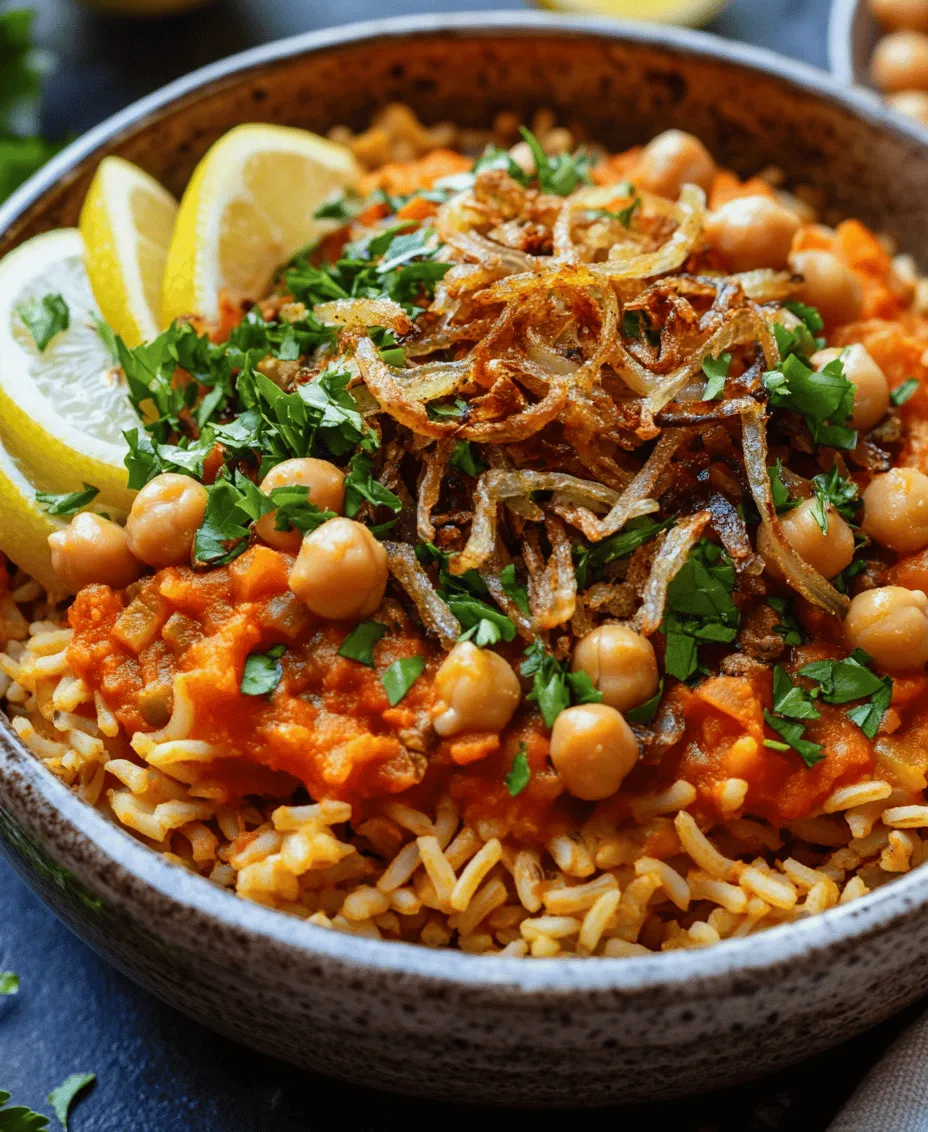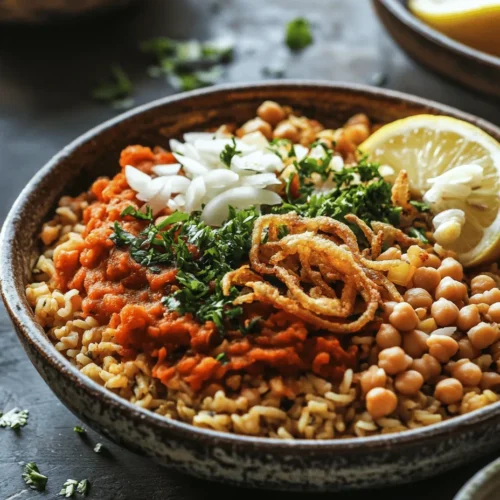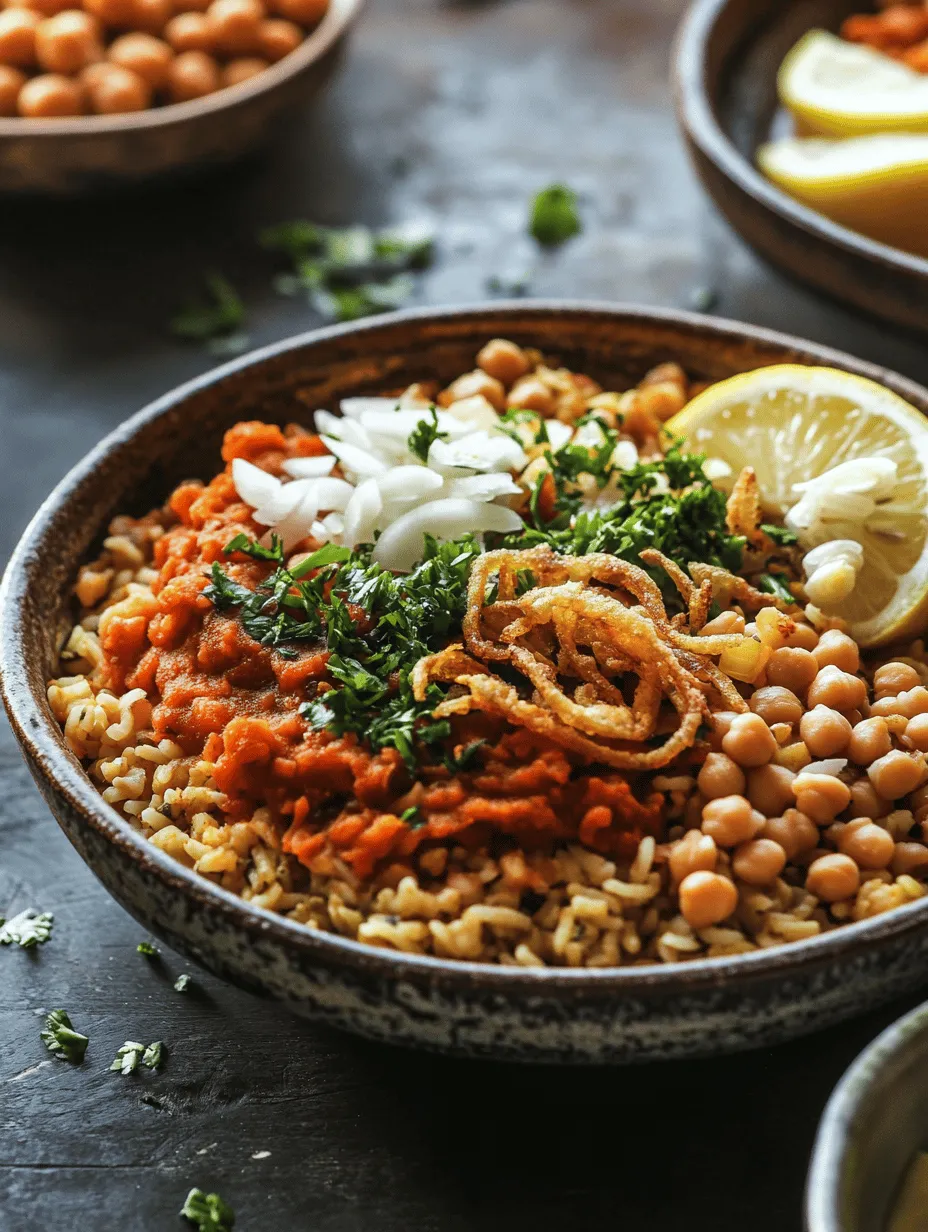Introduction
Koshari, a beloved staple of Egyptian cuisine, is much more than just a dish; it is a cultural icon that embodies the heart and soul of Egypt. Known for its hearty ingredients and comforting flavors, Koshari brings together a delightful combination of lentils, rice, macaroni, chickpeas, and a rich, zesty tomato sauce. This vegetarian dish has earned its place as a favorite among locals and visitors alike, often found in bustling street food stalls and cozy home kitchens across the country.
The combination of textures and flavors in Koshari makes it not only satisfying but also nourishing. With its layers of protein from the lentils and chickpeas, carbohydrates from the rice and pasta, and the tangy kick of the tomato sauce, Koshari is a well-rounded meal that appeals to a wide range of palates. This dish is not just a meal; it is a celebration of Egyptian culture, showcasing the country’s culinary heritage and its ability to blend various influences into a delicious and accessible dish.
The History of Koshari
Koshari has a storied past that reflects the rich tapestry of Egypt’s culinary landscape. The dish is believed to have originated in the 19th century, with roots tracing back to a time when various cultures converged in Egypt, particularly in the bustling port city of Alexandria. Its development is often attributed to the influence of Italian and Indian cuisines, which introduced pasta and lentils into the Egyptian diet. Over the years, Koshari has evolved from a simple street food into a celebrated national dish, emblematic of Egyptian hospitality and communal dining.
Historically, Koshari was a meal for the working class, providing a hearty and affordable option that could sustain laborers throughout the day. As Egypt modernized, Koshari found its way into restaurants and homes, becoming a beloved meal for families and a must-try dish for tourists. The dish’s ability to cater to diverse dietary needs—especially its vegetarian appeal—has solidified its status in Egyptian cuisine.
Street food culture plays a significant role in the popularity of Koshari. Vendors can be found across major cities, serving generous portions of this flavorful dish to eager customers. The atmosphere surrounding Koshari stalls is often vibrant and lively, capturing the essence of Egyptian life and community. Today, Koshari remains a symbol of national pride and an enduring favorite, enjoyed by people from all walks of life.
Ingredients Breakdown
To create the perfect Koshari, a careful selection of ingredients is essential. Each component contributes to the dish’s overall flavor and texture, making it a culinary masterpiece. Here’s a detailed breakdown of the key ingredients:
Lentils
Lentils are the backbone of Koshari, providing both nutrition and a hearty texture. Green or brown lentils are typically used, known for their robust flavor and ability to hold their shape during cooking. Packed with protein, fiber, and essential vitamins, lentils are an excellent source of plant-based nutrition that enhances the dish’s heartiness.
Rice
The choice of rice is crucial in achieving the ideal consistency for Koshari. Long-grain rice is preferred, as it cooks up fluffy and separates easily, allowing it to blend seamlessly with the other ingredients. The rice absorbs the flavors of the spices and sauces, contributing to the dish’s overall depth.
Macaroni
Macaroni adds a delightful twist to Koshari, providing a contrasting texture to the lentils and rice. The type of macaroni used can vary, but small shapes like elbow or ditalini are commonly preferred. This ingredient not only adds to the dish’s volume but also enhances its comfort food appeal.
Chickpeas
Chickpeas are another essential element of Koshari, offering a boost of protein and fiber. These legumes add a creamy texture and nutty flavor that complements the other ingredients beautifully. Whether using canned or dried chickpeas, they enrich Koshari’s heartiness and make it a filling meal.
Onions
Caramelized onions are a significant flavor enhancer in Koshari. When cooked until golden brown, they develop a sweet and savory profile that elevates the dish. Their rich flavor adds depth and complexity, making them a crucial component in the overall taste of Koshari.
Garlic and Tomato Sauce
The combination of garlic and tomato sauce forms the flavorful base of Koshari. Fresh garlic adds an aromatic kick, while the tomato sauce provides acidity and thickness. Together, they create a rich sauce that ties all the ingredients together, infusing the dish with a tangy, vibrant flavor.
Spices
A blend of spices is essential for creating the signature flavor profile of Koshari. Common spices include cumin, coriander, paprika, and cayenne pepper, each contributing its unique characteristics. Cumin and coriander provide warmth and earthiness, while paprika adds a touch of sweetness and color. A hint of cayenne pepper can introduce a subtle heat, balancing out the dish’s flavors.
Vinegar
Vinegar plays an integral role in Koshari, helping to brighten and balance the flavors of the dish. A splash of vinegar enhances the acidity of the tomato sauce and complements the richness of the other ingredients. It is often added just before serving, ensuring a fresh and lively taste.
Garnishes
Finally, garnishes such as fresh parsley and lemon wedges are important for completing the dish. Chopped parsley adds a pop of color and freshness, while a squeeze of lemon juice introduces a refreshing tang that cuts through the richness of the Koshari. These finishing touches are not just for aesthetics; they elevate the overall flavor experience.
Step-by-Step Cooking Instructions
Preparing Koshari involves several steps, but the process is straightforward and rewarding. Follow these clear instructions to create this delicious dish at home:
1. Prepare the Ingredients: Begin by rinsing the lentils and soaking the chickpeas (if using dried) overnight. Chop the onions and garlic, and gather your spices and sauces.
2. Cook the Lentils: In a medium pot, add the lentils to boiling water and cook until tender but not mushy, about 15-20 minutes. Drain and set aside.
3. Cook the Rice: In a separate pot, bring water to a boil and add the rinsed rice. Season with salt and let it simmer until the rice is cooked through and fluffy, approximately 15-18 minutes.
4. Cook the Macaroni: In another pot, bring water to a boil and add the macaroni. Cook according to package instructions until al dente, then drain and set aside.
5. Caramelize the Onions: In a large skillet, heat oil over medium heat. Add the chopped onions and sauté until golden brown and caramelized, stirring frequently to prevent burning.
6. Prepare the Tomato Sauce: In the same skillet, add garlic and cook until fragrant, about 30 seconds. Pour in the tomato sauce and sprinkle in the spices (cumin, coriander, paprika, and cayenne). Stir well and let it simmer for about 10 minutes.
7. Combine Ingredients: In a large serving bowl, layer the cooked rice, followed by the lentils, macaroni, and chickpeas. Pour the tomato sauce over the top, ensuring an even distribution.
8. Garnish and Serve: Finish with caramelized onions, a sprinkle of fresh parsley, and lemon wedges on the side. Serve warm and enjoy the flavors of this iconic Egyptian dish.
By following these steps, you’ll create a delicious Koshari that captures the essence of Egyptian cuisine, bringing a taste of Egypt right to your table. Stay tuned for the continuation of the recipe, where we will explore further tips and variations to enhance your Koshari experience.

Cooking the Lentils: Tips for Perfect Texture and Avoiding Mushiness
To achieve the perfect lentils for your Koshari, it’s essential to use the right type of lentils and cook them properly. Brown or green lentils are preferred for their ability to hold their shape during cooking. Begin by rinsing the lentils under cold water to remove any debris.
Cooking Steps:
1. In a medium saucepan, combine 1 cup of lentils with 3 cups of water.
2. Bring the water to a boil, then reduce the heat to a gentle simmer.
3. Cook the lentils for about 20-25 minutes, or until they are tender but still firm. Be cautious not to overcook them, as they can become mushy.
4. Once cooked, drain the lentils and set them aside.
Tips:
– To prevent mushiness, consider soaking lentils for 1-2 hours before cooking, which can reduce cooking time and improve texture.
– Adding a bay leaf or a clove of garlic while cooking can enhance the flavor of the lentils without overpowering the dish.
Cooking the Rice: Ensuring the Right Water-to-Rice Ratio for Fluffiness
Rice is a crucial component of Koshari, and achieving fluffy, separate grains is vital for the overall texture of the dish. Long-grain rice, such as basmati, works best for this recipe.
Cooking Steps:
1. Rinse 1 cup of long-grain rice under cold water until the water runs clear. This helps remove excess starch.
2. In a large pot, add the rinsed rice along with 2 cups of water and a pinch of salt.
3. Bring the mixture to a boil, then reduce the heat to low and cover the pot with a lid.
4. Cook for about 15-20 minutes, or until the rice has absorbed all the water.
5. Once done, remove from heat and let it sit covered for another 10 minutes before fluffing with a fork.
Tips:
– The water-to-rice ratio is crucial; using too much water can lead to mushy rice. Stick to the 2:1 ratio for long-grain rice.
– If you’re feeling adventurous, sauté the rice in a little olive oil before adding water to give it a nutty flavor.
Preparing the Macaroni: Importance of Cooking Al Dente for Texture Contrast
In traditional Koshari, the macaroni adds a delightful contrast in texture to the dish. It’s important to cook the pasta just right, so it maintains its shape and provides a satisfying bite.
Cooking Steps:
1. In a large pot of boiling salted water, add 1 cup of small pasta, such as elbows or ditalini.
2. Cook according to package instructions, usually around 7-9 minutes, until al dente.
3. Drain the pasta and rinse it under cold water to stop the cooking process.
Tips:
– Adding a splash of olive oil to the pot can help prevent the pasta from sticking together.
– Tossing the drained pasta with a little olive oil can also help maintain its texture until you’re ready to combine it with the other ingredients.
Frying the Onions: Techniques for Achieving Crispy, Golden-Brown Onions
Crispy fried onions are a quintessential topping for Koshari, adding a burst of flavor and texture. Getting them golden brown requires patience and attention.
Frying Steps:
1. Slice 2 large onions thinly.
2. In a deep frying pan, heat about 1 cup of vegetable oil over medium heat.
3. Once the oil is hot, add the sliced onions in batches to avoid overcrowding the pan.
4. Fry the onions for about 10-15 minutes, stirring frequently until they turn golden brown and crispy.
5. Remove the onions with a slotted spoon and drain them on a paper towel.
Tips:
– Keep an eye on the onions as they can quickly go from perfectly fried to burnt.
– For healthier alternatives, consider baking the onions in the oven at 400°F (200°C) until crispy for a reduced-fat option.
Making the Tomato Sauce: Balancing Flavors and Achieving the Right Consistency
A flavorful tomato sauce is essential for Koshari, bringing all the components together. The sauce should be rich and slightly tangy.
Sauce Steps:
1. In a saucepan, heat 2 tablespoons of olive oil over medium heat.
2. Add 4 minced garlic cloves and sauté until fragrant, about 1 minute.
3. Pour in a 14-ounce can of crushed tomatoes, along with 1 teaspoon of cumin, 1 teaspoon of coriander, and salt and pepper to taste.
4. Let the sauce simmer for about 15-20 minutes, stirring occasionally until it thickens slightly.
Tips:
– Adjust the seasoning to your taste; adding a pinch of sugar can help balance the acidity of the tomatoes.
– For extra depth, consider adding freshly chopped herbs like basil or parsley at the end of cooking.
Combining the Ingredients: Layering Techniques for Visual Appeal and Flavor Melding
Once all your components are ready, it’s time to layer them together for a beautiful presentation. Koshari is not just a dish; it’s a work of art.
Combining Steps:
1. Start with a base of rice on a large platter or individual bowls.
2. Layer the lentils over the rice, followed by the cooked macaroni.
3. Generously spoon the tomato sauce over the top, ensuring all components are well coated.
4. Finish with a sprinkle of crispy fried onions for that delicious crunch.
Tips:
– Layering can be done in individual bowls for a personal touch.
– Consider adding a drizzle of hot sauce or vinegar for those who enjoy a spicy kick.
Final Touches: Serving Suggestions and Presentation Ideas
Koshari is often served with a side of salad or pickled vegetables, enhancing both flavor and texture.
Serving Suggestions:
– Accompany Koshari with a simple cucumber and tomato salad dressed lightly with lemon juice and olive oil.
– Offer pickled turnips or beets on the side for a tangy contrast to the dish’s richness.
Presentation Ideas:
– Serve Koshari in a large, shallow dish for a family-style meal, allowing guests to help themselves.
– Garnish with fresh herbs like parsley or coriander for a pop of color.
Nutritional Value of Koshari
Koshari is not only delicious but also packed with nutrients, making it a wholesome meal option.
Nutritional Analysis:
– A typical serving of Koshari contains a healthy balance of protein from lentils, carbohydrates from rice and pasta, and fiber from legumes.
– On average, one serving can provide around 15 grams of protein, 35 grams of carbohydrates, and a significant amount of dietary fiber, which is beneficial for digestive health.
Balanced Diet Fit:
– Koshari is suitable for vegetarian diets due to its plant-based ingredients and can easily be part of a balanced meal when paired with vegetables.
– The dish offers a good mix of macronutrients and is relatively low in fat, especially if you opt for less oil in frying.
Legumes and Whole Grains Benefits:
– Incorporating legumes like lentils into your diet can help lower cholesterol levels and improve heart health.
– Whole grains, such as the rice used in Koshari, provide essential nutrients and can aid in weight management.
Variations of Koshari
Koshari has various interpretations, both traditional and modern, reflecting regional flavors and personal preferences.
Traditional vs. Modern Interpretations:
– Traditional Koshari is simple, featuring the core ingredients of rice, lentils, macaroni, and a tomato sauce.
– Modern versions may include additional ingredients like chickpeas, roasted vegetables, or different types of pasta.
Ingredient Substitutions:
– For those with dietary restrictions, gluten-free pasta can be used in place of regular macaroni.
– You can also experiment with adding different vegetables, such as sautéed bell peppers or zucchini, for extra nutrition and flavor.
Regional Variations:
– In different regions of Egypt, Koshari may be spiced differently or served with additional garnishes, showcasing how diverse this dish can be.
– Some areas might add a dash of vinegar or a spicy sauce, while others prefer a milder flavor profile.
Cultural Significance of Koshari
Koshari is more than just a meal; it’s a cultural icon in Egypt, symbolizing hospitality and the warmth of home-cooked food.
Symbol of Hospitality:
– Koshari is often served during gatherings and celebrations, showcasing the generosity of hosts.
– It’s common in both street food stalls and home kitchens, reflecting its popularity across all social classes.
Presence in Celebrations:
– Many Egyptian families consider Koshari a staple during festive occasions, where it brings people together.
– The communal aspect of enjoying Koshari enhances its significance, as families gather around to share this beloved dish.
Anecdotes from Locals:
– Locals often share stories of how Koshari has been a part of their family traditions, passed down through generations.
– Many fondly recall their first experience with Koshari at street vendors, making it a nostalgic dish linked to childhood memories.
Conclusion
Koshari stands out as a beloved Egyptian dish that encapsulates the essence of comfort food. Its rich history, nutritional benefits, and versatility make it an inviting option for any meal. The layers of rice, lentils, macaroni, and tomato sauce create a harmonious blend of flavors and textures that can bring families and friends together.
As you explore the world of Koshari, consider trying your hand at making this dish at home. Whether you stick to traditional recipes or experiment with modern variations, the experience of creating and sharing Koshari is sure to enrich your culinary journey. Embrace the warmth and hospitality that Koshari represents, and enjoy the rich flavors of Egypt right in your kitchen.



